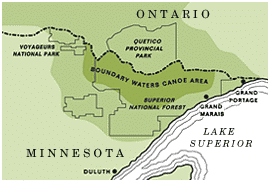
The Superior National Forest recently began the environmental review process to consider changing how the agency manages motorized boats that ferry people and canoes into parts of the Boundary Waters Canoe Area Wilderness. As a first step, the Forest Service is accepting comments through the end of this year on the initial phase of analysis.
“Addressing commercial towboat use and recreation special use permitting will help maintain or improve the Forest-wide recreational experience and social and physical resource conditions in the BWCAW,” the agency says.
Managing motors
While most motor use in the Boundary Waters is prohibited by law, exceptions were included in the legislation of 1964 and 1978 to allow certain existing levels. Amid disagreements about what the allowed levels are, how it’s tracked, and what the future of towboats should be, the Forest Service is now considering an update to its management plan to address the issue.
The existing lakes and horsepower limits for towboats are:
- Clearwater, North Fowl, South Fowl, and Seagull (no motors west of Three Mile Island) Lakes, and sections of Island River on the Tofte District (10 hp limit).
- Basswood (except that portion north of Jackfish Bay and Washington Island), Saganaga (except that portion west of American Point), Fall, Newton, Moose, Newfound, Sucker, Snowbank, East Bearskin,
- South Farm, and Trout Lakes (25 hp limit).
- Little Vermilion and Loon Lakes, and Lac La Croix (not beyond the south end of Snow Bay in the U.S.A.).
- Loon River (no hp limit).
At this point in the process, the Forest Service is requesting comments on the current towboat limits and potential changes to the regulations. Specific topics under consideration are:
- Extent to which commercial towboats are necessary for wilderness purposes
- Impacts of commercial towboats on wilderness character
- Commercial service operations
- Adhering to the Forest motorboat quota, and base period use
The Superior National Forest has had a moratorium in effect for any new towboat permits since 2018, while it considers existing limits and how to manage towboats. Earlier this summer, a federal judge in a lawsuit filed to force changes in towboat management ordered the agency to keep the halt in new permits until the litigation is settled.
“The Forest Service must consider management efforts for preserving wilderness character per law and policy,” the agency says. “This includes analyzing commercial use capacities, visitor encounters, crowding, campsite availability, noise, and physical resource damage in the Wilderness.”
Steady demand
Accurate numbers of towboats entering the wilderness have long been difficult to document. But starting in 2015, the Forest Service began collecting data more systematically. Since then, usage has remained more or less flat across the Boundary Waters, but has risen on some lakes while declining on others. Data since 2020, with increased use and changes in visitor use patterns, is not yet available.
Between 2015 and 2020, the number of recorded towboat trips on the Moose Lake chain, the busiest area for towboats, dropped by nearly a third, from 3,224 to 2,316. But on Seagull Lake, the number of trips went from 18 to 124. On nearby Saganaga, trip numbers went from 722 to more than 900, before dropping back to 863 in 2020 (the season was shortened due to pandemic restrictions).
Comments are now being accepted, with a deadline of January 1, 2024. Comments can be submitted using an online form.
More information:
- Boundary Waters Canoe Area Wilderness Towboats Management – U.S. Forest Service
- WW Sues to Stop Motorboat Abuse in Boundary Waters – Wilderness Watch

